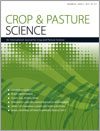CP12403Phenotypic diversity and relationships among a worldwide durum wheat (Triticum turgidum L. var. durum) germplasm collection under rainfed conditions of Iran
This study was carried out to measure the phenotypic diversity among 380 durum wheat landraces and the relationships among landraces with different geographical regions. The landraces with a wide genetic diversity were identified and can be used to achieve breakthrough in the durum wheat genetic improvement.




